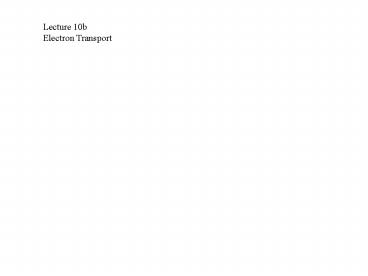Lecture 10b - PowerPoint PPT Presentation
1 / 16
Title:
Lecture 10b
Description:
DGO' = 2 * 23.2 * ( 1.14) = -53 kcal/mole. ATP formation = 7.3 kcal/mol. Max. amount of ATP 7 moles; Reality 3. FADH2 O2 FAD H2O. FAD 2e- 2 H FADH2 Eo' ... – PowerPoint PPT presentation
Number of Views:29
Avg rating:3.0/5.0
Title: Lecture 10b
1
Lecture 10b Electron Transport
2
DGO -n F DEO
Number of electrons transferred
Potential difference
Faraday 23.2 kcal/mol
NADH H ½ O2 ? NAD H2O
DEo 1.14 V
DGO 2 23.2 (1.14) -53 kcal/mole
ATP formation 7.3 kcal/mol
Max. amount of ATP gt 7 moles Reality 3
3
FADH2 ½ O2 ? FAD H2O
FAD 2e- 2 H ? FADH2 Eo 0 V
½ O2 2e- 2 H ? H2O Eo 0.82 V
FADH2 ? FAD 2e- 2 H Eo -0 V
FADH2 ½ O2 ? FAD H2O DEo 0.8 V
- Go - nF D Eo
- - -2 x 23.2 x 0.8 -37.1 kcal /mol
4
General Principles
High Energy
Low Energy
DEo - negative
DEo - positive
NAD/NADH
O2/ H2O
Easy to oxidize (spontaneous)
Easy to reduce
Reduced by compounds with a negative DEo
Requires energy to reduce
Energy obtained from oxidation of glucose
Energy is released which is used to make ATP
5
The Mitochondrial Electron Transport Chain
NADH? CoQ? bc1 complex ? cyt c ?cytaa3? O2
Cytochrome c
Cytochrome b Cytochrome c1
Coenzyme Q
Cytochrome a Cytochrome a3
6
What is a quinone 2 electron carrier 2H
O !!
OH !
2e- 2H?
!! O
! OH
Similar to NAD and FADH2
Hydrogen carriers
7
Electron carriers carry only electrons e-
- Fe Cu
Fe3 e- ? Fe2
Heme proteins cytochromes (cyt)
8
Cytochromes
9
The chain is branched.
NADH? CoQ? bc1 complex ? cyt c ?cytaa3? O2
FADH2
10
The electron transport chain consists of large
multisubunit complexes separted by small, mobile
electron carriers.
Complex IV
Complex III
Complex I
NADH? CoQ? bc1 complex ? cyt c ?cytaa3? O2
FADH2
Complex II
Mobile electron carriers CoQ and cyt c
11
Mitochondria
Internal membrane cristae Electron transport,
H ion transport ATP
formation
12
Intermembrane space
e-
I III
IV
Ccyt c
CoQ
NADH
O2
Matrix
13
DEo - negative high energy NADH
FADH2
DEo positive low energy O2
Energetics of electron transport
14
Take home lessions
- The energy rich electrons are
- passed down an electron transport chain.
- From electron carrier to electron
- carrier.
3. Until they reach O2 producing H2O
- Energy is released which is conserved
- as ATP.
15
5. The electron carriers are found in the inner
membrane of the mitochondrion
6. There are four large electron
transport complexes (Complexes I?4 and two small
electron carriers (CoQ and cyt c)
16
7. Electron carriers come in two types. Carry
electrons cytochromes Fe3 1e- ? Fe2 cyt b,
cyt c, cyt aa3 Carry electrons hydrogens CoQ
2e- 2H ? CoQH2 NADH, NADPH, FADH2, FMNH2































